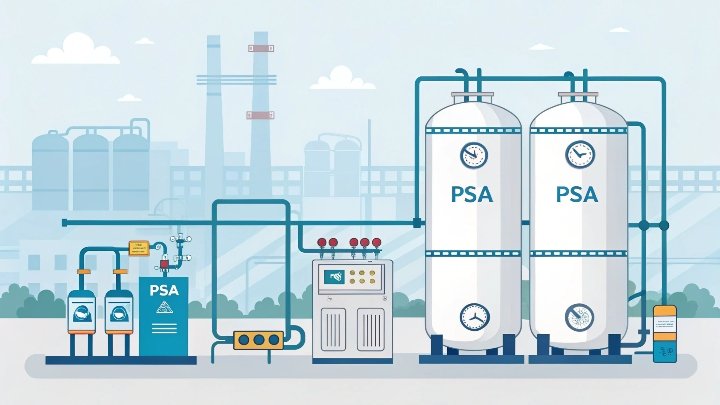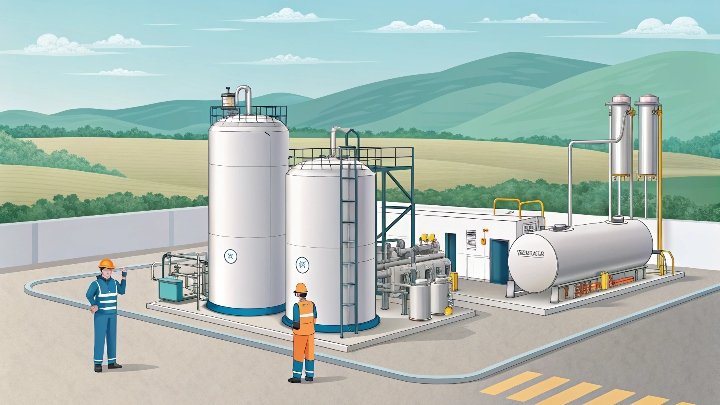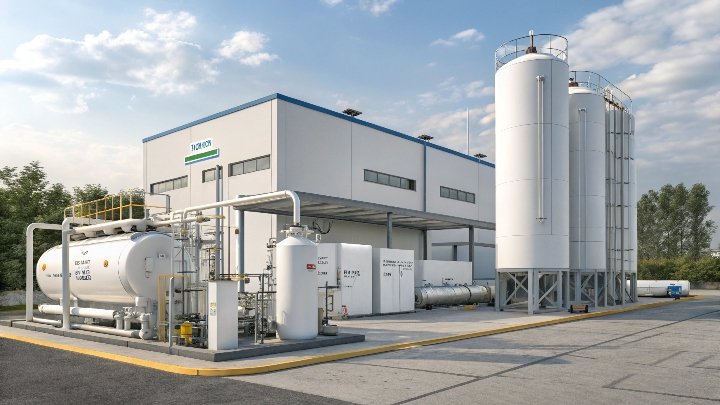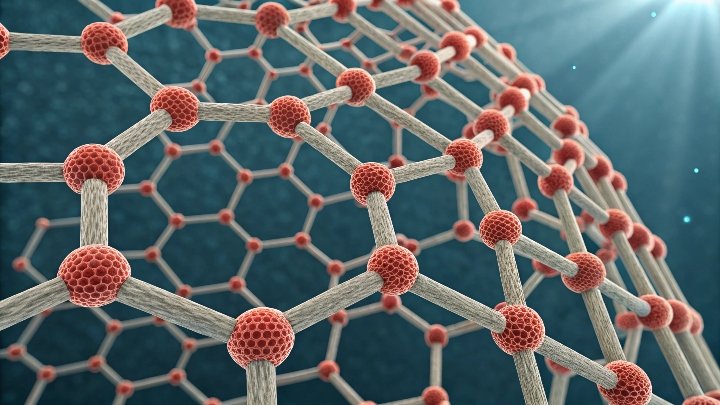Are you struggling to select the right molecular sieve? This confusion can cost time and money. I want to share a simple approach that solves this problem.
The best approach is to consider the feed gas conditions, target oxygen purity, and the performance of different zeolites. Typically, 13X provides stronger nitrogen adsorption, making it more efficient than 5A. The right choice optimizes purity and extends service life.
I often see confusion around the differences between zeolite 13X and 5A, especially when designing PSA systems. I will share what I have learned from my own projects, so you can make a confident choice.
Is the difference between zeolite 13X and 5A a quality difference?
I'm worried about choosing the wrong sieve. This can lead to inconsistent purity. Let me clarify if the difference between 13X and 5A is simply a matter of quality.
5A is the first-generation molecular sieve, while 13X is an improved version. The distinction is not just quality but also adsorption capability. Each sieve performs differently because of unique pore structures, which affect nitrogen uptake and oxygen purity. Knowing these differences ensures a better match for your PSA needs.
I have encountered many projects where the choice between 5A and 13X led to confusion. I learned that each type is unique in pore size and structure, which affects adsorption speed and capacity. 5A has a nominal pore size of about 5 angstroms, which is suitable for separating smaller molecules like water and carbon dioxide. 13X, on the other hand, has a pore size of about 10 angstroms, which makes it more effective at capturing larger molecules like nitrogen. This difference impacts oxygen purity, system efficiency, and operating costs.
Key Factors
Here is a simple comparison table that highlights the most common considerations:
| Factor | Zeolite 5A | Zeolite 13X |
|---|---|---|
| Pore Size | ~5 angstroms | ~10 angstroms |
| Adsorption Target | Small molecules (e.g., H2O, CO2) | Larger molecules (N2) |
| Efficiency | Good for basic PSA | Higher nitrogen capacity |
| Oxygen Purity | Up to moderate levels | Easier to reach higher purity |
| Cost | Often lower initial cost | Slightly higher but more efficient |
From my own observations, 5A can be a dependable choice when you deal with lower oxygen purity requirements or when moisture removal is a key concern. However, if you aim for higher oxygen purity, 13X offers a stronger capacity to adsorb nitrogen, which translates to better efficiency in PSA systems.
I have also noticed that 13X can handle slight variations in feed gas composition without dramatic drops in performance. This resilience can be important if the inlet air has fluctuating humidity or contaminants. Meanwhile, 5A works well if you have a stable air feed and do not require a very high oxygen concentration.
These differences do not strictly indicate that one is superior in quality across the board. Instead, they show each sieve's specific use case. 5A is a strong starter, but 13X improves on nitrogen adsorption, which often means higher purity and sometimes lower energy costs. Ultimately, you must pick the sieve that aligns with your PSA design parameters and target purity. Doing so can prevent long-term issues and help you achieve consistent results. In my experience, understanding these core factors leads to a clear path in deciding which sieve to use. When budgets are tight and moderate purity is enough, 5A works fine. If your priority is consistent high-purity oxygen, investing in 13X can pay off in both performance and reliability.
If we want to produce oxygen using (pressure swing adsorption) technology, do we need a mixture of zeolite 13X + 5A or use them separately?
I'm concerned about mixing 5A and 13X. This combination might seem appealing, but it can also create complexity. I want to share my experience with this choice.
Most PSA processes rely on a single type of zeolite, either 5A or 13X, for focused performance. Mixing them can introduce logistical and design challenges. Unless you have a specific application that benefits from dual-layer adsorbents, using them separately is usually more straightforward and effective.
I have faced situations where a client wanted to combine 5A and 13X in a single PSA tower. They hoped to get the best of both worlds: robust moisture and carbon dioxide removal from 5A, alongside higher nitrogen adsorption from 13X. While this idea seems attractive, it can lead to increased complexity in design, operation, and maintenance.
Different Functions
It is true that 5A excels at removing smaller molecules, especially water. If your feed air is not pre-dried, 5A can help reduce moisture. 13X is known for its superior nitrogen capacity, leading to higher oxygen purity. However, layering or mixing these adsorbents requires precise calculations. The flow dynamics inside the tower can become unpredictable. One layer may saturate faster, forcing more frequent regeneration cycles.
Practical Considerations
In my experience, using a single, well-chosen adsorbent simplifies the process. If you need more water removal, you can add a dedicated dryer or ensure your feed air is already dehydrated. This approach keeps your PSA cycle stable. Also, you avoid potential channeling or uneven distribution of gases that might occur when different sieves are packed together.
Here is a brief summary of potential pros and cons:
| Approach | Pros | Cons |
|---|---|---|
| Single Adsorbent | Simpler design, consistent performance | May require pre-drying to avoid moisture issues |
| Mixed Adsorbents | Potential for combined functionalities | Complex flow patterns, possible uneven saturation rates |
| Layered Adsorbents | Targeted removal at different stages of the bed | More challenging design, may need advanced control systems |
You can see that mixing or layering might be beneficial in specific niche scenarios, such as very high flow rates with inconsistent inlet conditions. However, for most standard PSA oxygen production, relying on one adsorbent typically offers a more stable and cost-effective solution. I have found that focusing on a single type, like 13X for higher purity or 5A for specific moisture removal tasks, yields reliable results. This decision helps avoid overcomplicating your system and saves on both capital and operational costs. Ultimately, clarity in your design goals leads to better performance and longer adsorbent life.
Which type of zeolite is better for producing high purity oxygen up to 95%?
I'm aiming for 95% oxygen purity. Without the right adsorbent, I risk lower yields and higher costs. Let me share what I discovered about maximizing purity.
Zeolite 13X is generally the best choice for reaching high oxygen purity, as it offers stronger nitrogen adsorption. This strength helps produce oxygen at concentrations of around 95%. Though 5A can work, it may not provide the same efficiency or stability for such high purity targets.
I remember the first time I needed to achieve 95% oxygen purity in a PSA system. I used 5A at first, but I struggled to maintain that high level of purity without increasing cycle times or adding extra steps. Eventually, I switched to 13X and saw a notable improvement in nitrogen capture, which made it easier to hit the 95% target.
Purity Mechanism
5A can remove some nitrogen, but its pore size is more tuned to smaller molecules. 13X has a larger pore volume and a higher affinity for nitrogen, which means it pulls more nitrogen out of the airflow. This process significantly elevates oxygen concentration. When aiming for 95% or higher, the difference in performance between 5A and 13X becomes more pronounced.
Operational Stability
Another advantage I noticed with 13X is the stability of the adsorption cycle over many runs. Once you have optimized the pressures and flow rates, 13X can maintain consistent purity. With 5A, I saw more fluctuations, especially when there were slight changes in temperature or feed air composition. For large-scale systems, these fluctuations can be costly and lead to more frequent maintenance.
Here is an overview of why 13X often excels for 95% purity:
While 5A is still used in many general applications, I believe 13X provides a clear advantage for those who demand around 95% oxygen. In my projects, the switch to 13X not only boosted purity but also reduced downtime and overall energy consumption. If your goal is to create a robust PSA process, 13X is the reliable option for high-purity targets.
If air drying is used, what is the service life of the zeolite at a constant discharge rate and a pressure not exceeding 8 bar?
I'm unsure about how long my molecular sieve will last under stable conditions. This doubt can disrupt planning. Let me explain the typical service life.
Under proper air drying and standard PSA operation (under 8 bar), most zeolites like 13X or 5A can last about 3 to 5 years. This estimate assumes consistent regeneration, minimal contamination, and stable feed conditions, which help preserve the adsorbent's performance over time.
During my early projects, I worried about the longevity of zeolite under constant conditions. In practice, the service life depends on several factors: feed air cleanliness, regeneration efficiency, and operational pressure. When the system is kept below 8 bar, the mechanical stress on the adsorbent is lower. This helps maintain pore structure and prevents attrition. If you also ensure the incoming air is well-dried or pre-treated, you minimize water and oil contaminants that can degrade the zeolite over time.
Regeneration Matters
I have noticed that regular and efficient regeneration cycles are critical for preserving adsorbent life. If moisture or other impurities remain in the pores, the zeolite’s capacity declines faster. A well-tuned cycle allows the bed to release trapped molecules without damaging the sieve. This balance is easier to maintain if the feed gas is already low in contaminants.
Monitoring Performance
In my experience, you should periodically test oxygen purity and check pressure drop across the bed. A sudden drop in purity or a noticeable rise in pressure drop might indicate that the zeolite is losing efficiency. Some operators also track cycle times. If you need to shorten cycles frequently to maintain purity, it could mean the zeolite is nearing the end of its useful life.
Based on these observations, a 3-to-5-year lifespan is realistic for 13X or 5A under stable conditions. Careful attention to feed quality, regeneration settings, and mechanical integrity can prolong this timeframe. By taking these steps, I have seen PSA systems run consistently without unexpected adsorbent replacements.
Conclusion
Selecting the right zeolite, understanding its unique features, and maintaining proper conditions can yield stable, high-purity oxygen and longer adsorbent life.







